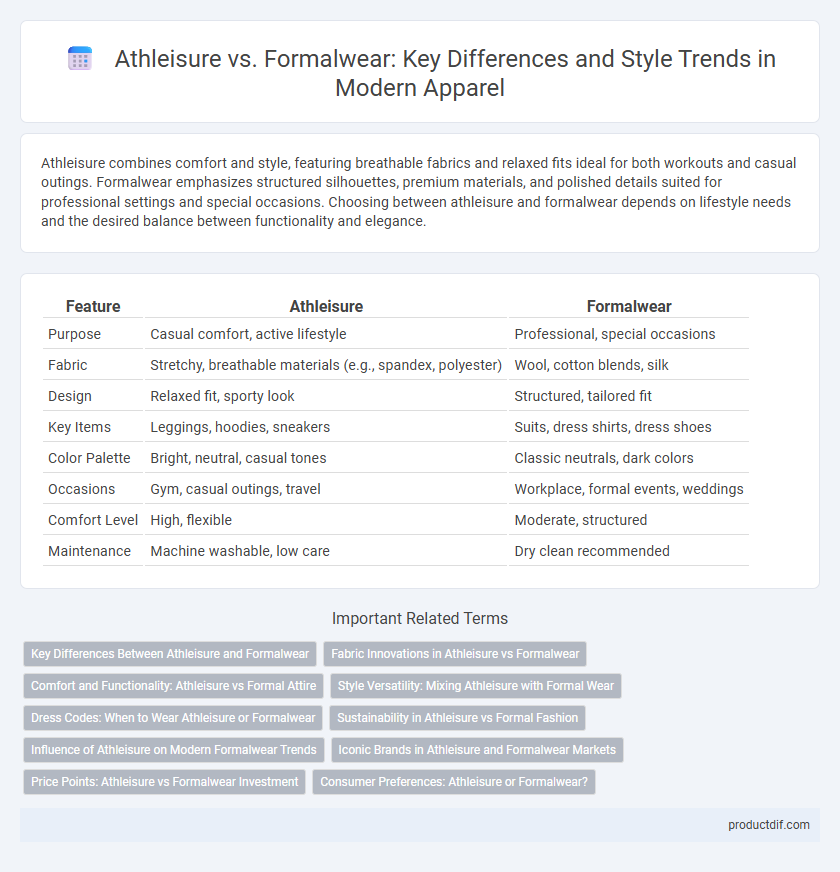Athleisure combines comfort and style, featuring breathable fabrics and relaxed fits ideal for both workouts and casual outings. Formalwear emphasizes structured silhouettes, premium materials, and polished details suited for professional settings and special occasions. Choosing between athleisure and formalwear depends on lifestyle needs and the desired balance between functionality and elegance.
Table of Comparison
| Feature | Athleisure | Formalwear |
|---|---|---|
| Purpose | Casual comfort, active lifestyle | Professional, special occasions |
| Fabric | Stretchy, breathable materials (e.g., spandex, polyester) | Wool, cotton blends, silk |
| Design | Relaxed fit, sporty look | Structured, tailored fit |
| Key Items | Leggings, hoodies, sneakers | Suits, dress shirts, dress shoes |
| Color Palette | Bright, neutral, casual tones | Classic neutrals, dark colors |
| Occasions | Gym, casual outings, travel | Workplace, formal events, weddings |
| Comfort Level | High, flexible | Moderate, structured |
| Maintenance | Machine washable, low care | Dry clean recommended |
Key Differences Between Athleisure and Formalwear
Athleisure combines comfort and functionality with stylish designs, often featuring breathable fabrics like spandex and polyester blends, ideal for casual and athletic activities. Formalwear emphasizes structured, tailored fits using materials such as wool, silk, and cotton blends, designed for professional or special occasions. The primary distinctions lie in fabric performance, dress code appropriateness, and the intended use, with athleisure prioritizing versatility and ease of movement while formalwear upholds elegance and sophistication.
Fabric Innovations in Athleisure vs Formalwear
Athleisure fabrics incorporate moisture-wicking, stretchable, and breathable materials like spandex blends and engineered mesh for enhanced comfort and performance, contrasting with formalwear fabrics that rely on traditional wool, silk, and cotton with innovations such as wrinkle-resistant and stain-repellent treatments. Recent advancements in athleisure emphasize sustainable, recycled fibers and antimicrobial finishes to meet active lifestyles, while formalwear innovations focus on luxurious textures combined with smart textiles for temperature regulation. These fabric innovations highlight the evolving priorities in comfort, functionality, and sustainability between athleisure and formalwear categories.
Comfort and Functionality: Athleisure vs Formal Attire
Athleisure apparel prioritizes comfort and functionality, featuring breathable fabrics, flexible fits, and moisture-wicking technology suitable for active lifestyles. Formalwear, designed for elegance and professionalism, often uses structured materials that offer limited stretch and breathability, impacting overall comfort during extended wear. The growing demand for adaptable attire has elevated athleisure's popularity as it seamlessly combines style with practicality for daily activities.
Style Versatility: Mixing Athleisure with Formal Wear
Combining athleisure with formalwear enhances style versatility by blending comfort and sophistication for a modern, dynamic look. Incorporating tailored joggers or sleek sneakers with structured blazers creates a balanced outfit suitable for both casual and professional settings. This fusion empowers individuals to seamlessly transition from workouts to meetings, reflecting contemporary fashion trends prioritizing multifunctionality.
Dress Codes: When to Wear Athleisure or Formalwear
Athleisure is ideal for casual environments, gym sessions, or weekend outings where comfort and flexibility are prioritized, often featuring moisture-wicking fabrics and stretchy materials. Formalwear suits corporate meetings, weddings, and upscale events, emphasizing tailored fits, quality fabrics like wool or silk, and conservative color palettes. Understanding the specific dress code of an event or workplace ensures appropriate attire, balancing style with context-appropriate functionality.
Sustainability in Athleisure vs Formal Fashion
Athleisure often incorporates sustainable materials like organic cotton, recycled polyester, and biodegradable fabrics, reducing its environmental footprint compared to traditional formalwear, which frequently relies on resource-intensive textiles such as wool and silk. The production of athleisure garments emphasizes eco-friendly manufacturing processes and durability, promoting longevity and reducing waste, whereas formalwear typically involves complex dyeing and finishing techniques that contribute to higher pollution levels. Brands in the athleisure market increasingly prioritize transparency, ethical sourcing, and circular fashion initiatives, setting a benchmark for sustainability that formal fashion houses are gradually beginning to address.
Influence of Athleisure on Modern Formalwear Trends
Athleisure has significantly influenced modern formalwear by introducing comfortable fabrics such as stretch wool and performance blends, promoting a fusion of style and functionality. Designers integrate sporty details like elastic waistbands, moisture-wicking materials, and casual silhouettes into traditional suits and dresses, catering to a demand for versatile office-to-evening wear. This trend reflects a shift toward relaxed dress codes and prioritizes comfort without sacrificing professionalism in corporate and social environments.
Iconic Brands in Athleisure and Formalwear Markets
Nike and Lululemon dominate the athleisure market with innovative fabrics and stylish, performance-driven designs. In formalwear, brands like Armani and Hugo Boss maintain a stronghold by blending classic tailoring with modern elegance. The distinct branding strategies reflect athleisure's focus on comfort and activity, while formalwear emphasizes sophistication and tradition.
Price Points: Athleisure vs Formalwear Investment
Athleisure offers affordable price points ranging from $30 to $150 for quality pieces, making it accessible for everyday wear. Formalwear typically requires a higher investment, with suits and dresses priced between $200 and $1,000 or more due to premium fabrics and tailoring. The cost disparity reflects the intended use, durability, and craftsmanship, with formalwear often serving special occasions versus athleisure's focus on comfort and versatility.
Consumer Preferences: Athleisure or Formalwear?
Consumer preferences in apparel reveal a growing inclination toward athleisure due to its comfort, versatility, and suitability for remote work and casual environments. Formalwear remains preferred for professional settings and special occasions, driven by its association with sophistication and dress codes. Market trends indicate younger demographics increasingly favor athleisure, while formalwear maintains steady demand among older consumers and corporate sectors.
Athleisure vs Formalwear Infographic

 productdif.com
productdif.com